Pergolas are a great and versatile addition to nearly any landscape design. They can function as a simple shade structure over a sitting area or become an extension of a living space, housing an outdoor kitchen or bar. Placed over a outdoor fireplace or fire pit, they become a cozy gathering place where s’mores can be roasted and stories shared. The uses for a pergola extend as far as your imagination.
Just as the uses for pergolas vary widely, so do the designs. The pergola size is up to you and most standard pergola dimensions can be adjusted and customized so the structure fits your client’s needs perfectly. When making size determinations, it’s important to understand what purpose the structure will fulfill and make the material and size determinations based on the desired need.
Pergola terminology
Understanding terminology associated with pergolas will go a long way in helping to measure for the correct size pergola, ensuring that installation goes smoothly, and the outdoor space can be enjoyed quickly.
Attached
An attached pergola uses an existing support structure wall or walls as support. The structure may be supported by columns on one side, completely by walls on two sides or a combination of both.
Freestanding
A freestanding pergola is supported by 4 or more columns and does not rely on a wall for support.
Columns/Posts
Columns are usually the base of a structure and support the beams on each side of the pergola. Columns are offered in a variety of styles to perfectly compliment the rest of the design.
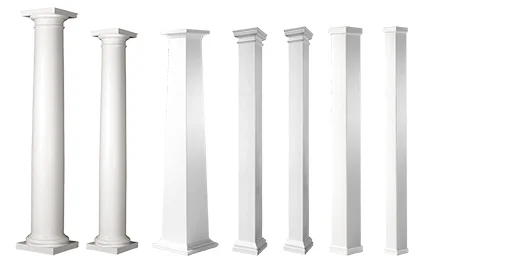
Beams
Beams are supported by the columns and run the width of a pergola or shade structure. Structureworks vinyl pergola kits and fiberglass pergola kits both feature two full size 2” x 8” beams on each side of a freestanding pergola and on one side of an attached pergola. cPVC pergolas feature beams that are 3 ½” x 9 ½”. The ends of the beams can be decorative with a standard design, or by creating a custom end design.
Rafters
Rafters offer the first layer of shade, are supported by the beams and run perpendicular to them. Structureworks vinyl pergola kits include 2” x 6” rafters while the fiberglass pergola kits include 2” x 8” rafters. cPVC pergola kits include 1 ½” x 7 ¼” rafters. The ends of the rafters can be decorative with a standard design, or use a custom end design.
Stringers/Purlins
Stringers are the main shade producing component, are supported by the rafters and run perpendicular to them. Structureworks vinyl pergola kits and cPVC pergola kits include 1 ½” square stringers and fiberglass pergola kits include 1 ¾” square stringers evenly spaced across the top of the pergola. If you’re seeking more shade the number of stringers can be increased to provide an even greater amount of shade.
Width
The width of a pergola is measured from one end of the beam to the other. This will be the same whether the pergola is attached or freestanding.
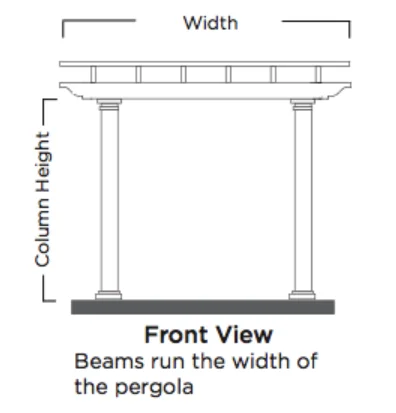
Projection/Length
The projection of a pergola is measured from one end of the rafter to the other. This measurement is dependent on whether the pergola is freestanding (left) or attached (right).
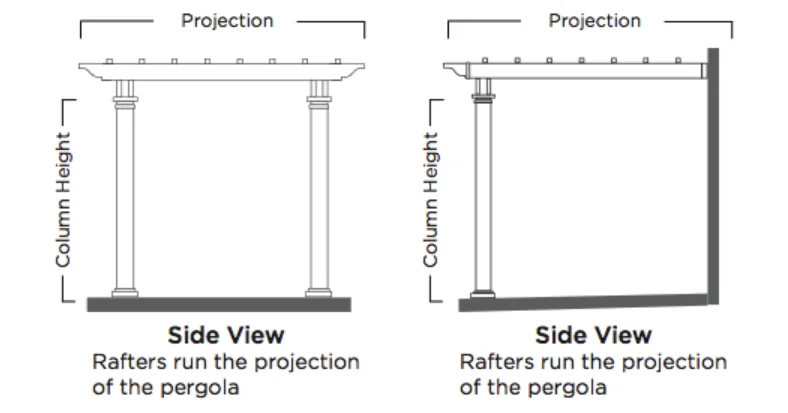
Ledger Board
The ledger board runs along the support structure wall for an attached pergola and supports the rafters where they meet the support structure.
Cantilever
The cantilever is the amount of overhang of the beams, rafters or stringers. Beams typically cantilever 24” from the center of the columns, and rafters typically cantilever 21” from the center of the columns.
Canopy
A canopy can be added to the pergola to increase the amount of shade underneath the structure. Canopies come in a variety of colors and styles and can be used to complete a pergola’s design.
Choosing the right material
Ultimately, the material that you choose for the pergola will dictate how the pergola is sized. Making sure to choose the right material to fit both your durability and sizing needs is essential to getting the perfect pergola.
Aluminum
Virtually indestructible, aluminum is perfect for commercial applications where the structure will get a lot of use. Structureworks aluminum pergolas are fully customizable and are finished with a powder coat finish.
cPVC
Cellular PVC (cPVC) is an incredibly strong and durable material perfect for commercial applications with high traffic areas. The rafters, beams, and ledgers of a cPVC pergola feature an aluminum core that is wrapped with cellular PVC, and the stringers are solid cPVC. The increased flexibility of this material allows for added customization with curves and arches if desired.
Fiberglass
Like aluminum and cPVC, fiberglass pergolas are low-maintenance and incredibly strong. Because of its innate strength, pultruded fiberglass allows for a very open structure with spans up to 22’ and a reduced number of support columns. Fiberglass pergolas are finished with the ColorLast paint process with 18 colors to choose from, increasing the number of customization options. Structureworks can also color match any color, ensuring that the pergola blends seamlessly into your existing design.
Vinyl
Vinyl pergolas are Structureworks least expensive option, but the lower price doesn’t compromise the quality or appearance. Made from our U.S. produced virgin vinyl, this option provides a high quality, low-maintenance structure that will withstand the test of time. Each vinyl pergola comes in an unpainted semi-gloss white finish that will create a beautiful addition to the landscape design.
How to measure for the pergola
Pergola sizes vary widely depending on the space and individual needs. The size of the pergola can be chosen from the standard pergola dimensions or a custom sized to fit the desired space and purpose.
Standard pergola dimensions are listed by the overall size of the top structure. Custom kits are usually sized by measuring the distance between column centers and adding in the length of the cantilever. Keep in mind that the width is the beam length and the projection is the rafter length.
Standard fiberglass dimensions

Standard cPVC dimensions
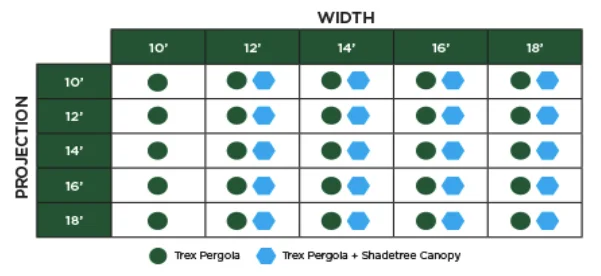
Standard vinyl dimensions
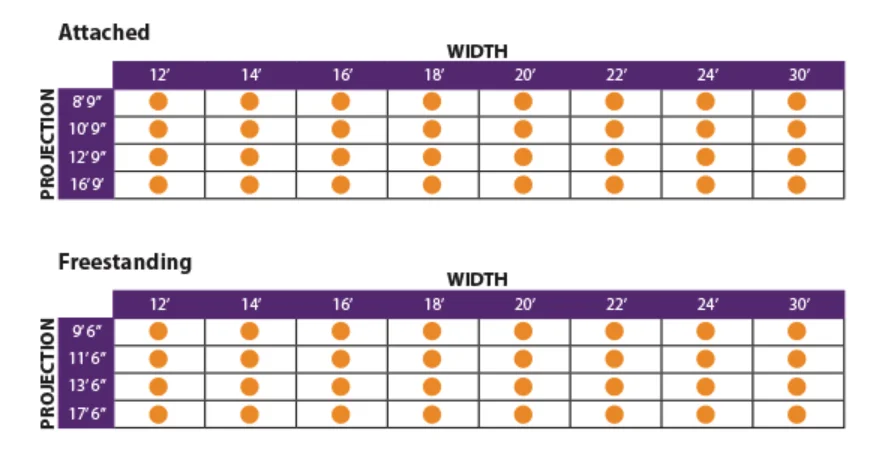
Choosing a standard pergola size can be as simple as checking a box on the order form. If you don’t see a size that works for the client’s space, you can provide measurements for the size you need or you can work with Structureworks to create a fully customized design.
Pergola Height
The height of a pergola can be determined by the height of the columns, available in either 8’ or 10’ height Columns can be trimmed onsite if a different height is needed. To determine the total height of the structure, add 16” to a vinyl structure, 18” to a fiberglass structure, and 18 ¼” to a cPVC structure to accommodate the distance from the top of the column to the top of the stringer. Since aluminum structures are custom sized, a Structureworks expert can work with you to determine the total height.
When measuring for an attached pergola, the height of the bottom of the ledger board can be found by adding the column height plus 8” (vinyl and fiberglass) or 9 ½” (cPVC) for the beam, as the ledger replaces the beams on the attached side. Rafters are then attached directly to the ledger.
Sizing properly for the application
Determining the size of the pergola and the appropriate materials relies heavily on its application. To help you get an idea of things to consider when making these decisions, we’ve included three examples of how to size properly for your desired application.
Multi-family apartment complex with space for grills and seating
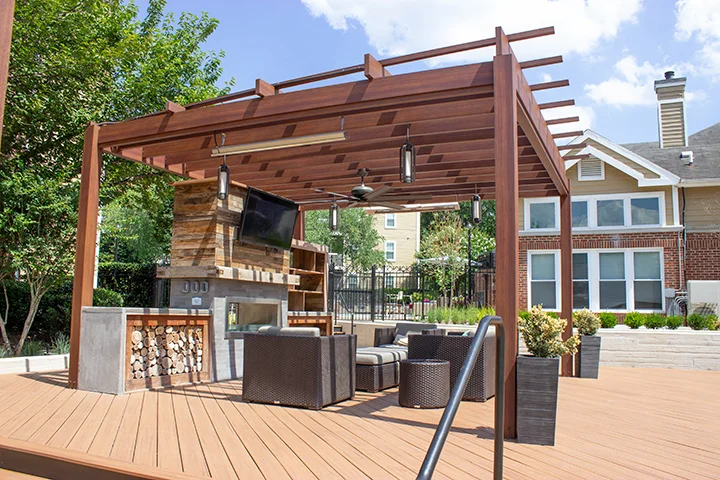
Pergolas used in a commercial property setting will likely encounter a lot of traffic and will need to maintain their appearance for many years. In this scenario of a multi-family apartment complex with space for grills and seating, it’s important to consider the durability of the material and the space needed.
Over an area that will include grills, the minimum height must be determined based on the proper amount of distance between the grill and the rafters or canopy to use the grills safely. While most grill manufacturers suggest 24-36 inches of clearance between the grill and any wall or surface, it’s important to refer to your specific grill’s manufacturer to ensure a safe environment for grilling. Another consideration is whether to include seating under the pergola or position it at the periphery. This decision will determine the width and projection.
Open courtyard for large gatherings
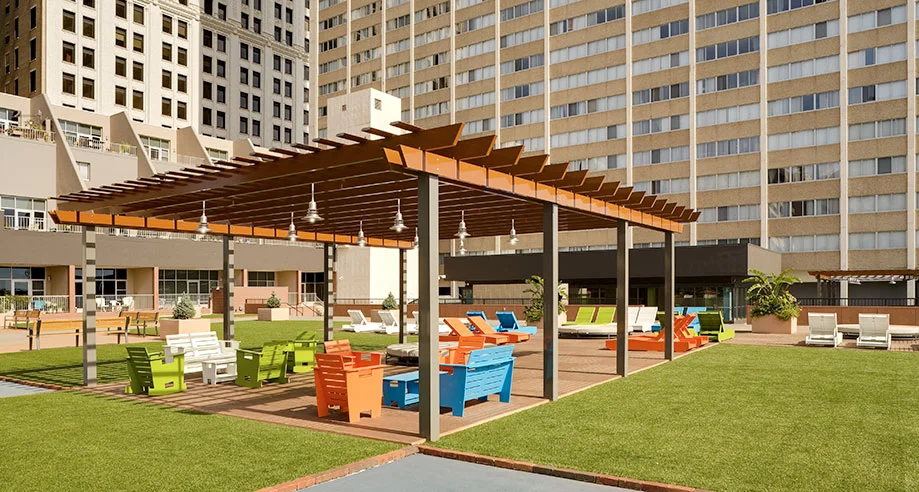
In a large and open courtyard such as this multi-family living space with no natural shade, providing protection from the sun is essential to creating a usable outdoor space. In this scenario, the size needed helps to determine the material selection.
Aluminum, Fiberglass and cPVC materials all allow for larger pergolas and longer spans than would typically be seen in a residential setting, making them perfect for commercial and common space applications.
Residential landscape structure
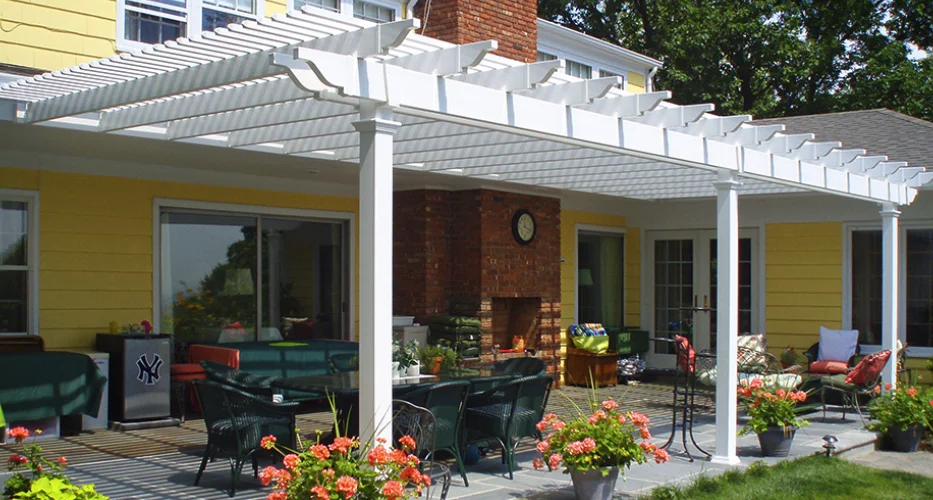
Sizing for residential use is based on a variety of factors. As with commercial applications, the space available is the first thing to take into consideration. If there is an existing patio, the pergola must be sized to fit within the space. Window placement and size can also help determine the height of the pergola and location of the columns so as not to obstruct the view.
One of the most important considerations when determining size is to consider where the sun rises and sets relative to the pergola. Designing a pergola’s width and projection to get the optimal amount of sun and shade will create a space that can be enjoyed for additional hours each day.
Design a Pergola with the Perfect Dimension
With careful planning and attention to both application and materials, you’re sure to create the perfect pergola that will please your client and last for years to come. For help designing the ideal pergola, contact Structureworks’s talented team of designers.